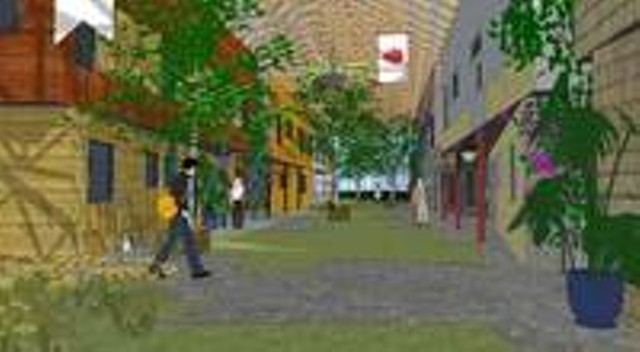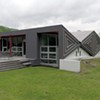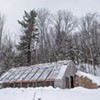Published July 11, 2007 at 3:19 p.m.
MANCHESTER — Imagine three acres of land in Manchester’s chi-chi retail shopping area hosting a vibrant community of walking paths, meadow and gardens surrounding a complex of affordable housing. No, not double-wides, but innovatively clustered mobile or modular homes designed by some of Vermont’s finest architects.
Earlier this month, a group of five architectural teams from around the state met for a daylong colloquium at Manchester’s Southern Vermont Arts Center to present potential routes in the search for “the Holy Grail of housing.” That is, sustainable, affordable homes for the Snow Belt.
Spearheaded by the Vermont Congress of Residential Architecture (CORA), the colloquium was the culmination of more than a year of collaboration. Early on, participants realized that in order to meet their goal of affordability, they would need to work within the manufactured-housing industry. CORA members vetted modular- and panelized-home companies from Québec to Boston, matching qualified manufacturers with architectural teams.
The five teams that finished the project were 2Morrow Studio of Warren, LineSync Architects of Wilmington, GVV Architects of Burlington, Watershed Studio of White River Junction and Ramsay Gourd Architects of Manchester. Each presented original plans for green-housing communities containing 21 to 55 affordable units, targeted at young families, recent college graduates and the elderly.
Reviewing these proposals was a 10-member board comprising builders, zoning administrators and developers, as well as representatives from organizations such as Efficiency Vermont, Vermont Green and the Vermont Green Building Network. The board members evaluated each team’s design and its viability with regard to environmental integrity, cost, maintenance and material use.
The colloquium centered on the Madeira Education Center on the 407-acre campus of SVAC. One large room was filled with tables and chairs and lined with multiple boards depicting architectural renderings of site plans, side elevations and structural details of each housing proposal. At times, smaller groups gathered outdoors around picnic tables, seeking shade in the near-90-degree weather.
John Rossi is the design principal of Powerhouse Enterprises, a Massachusetts start-up that aims to build modular, green homes. He acted as spokesperson for the review board, and praised the architectural teams for innovative design features such as maximized green space, passive solar energy use, energy-efficient wood stoves, compact plumbing and high-quality indoor air.
Home designs presented at the colloquium came in several genres, from GVV’s traditional row-house proposal to Watershed Studio’s ultra-modern, Cubist approach. John Connell, principal architect of 2Morrow Studio and founder of Yestermorrow Design/Build School, serves as head of Vermont CORA. His team configured a modular unit supplied by Customized Structures, Inc. of Claremont, N.H., to create three groupings of eight two-story homes — 24 total units. Each has a separate entrance and garden yet is connected to the other units by a glass atrium. “For families, the atrium could be used for dinners, parties, and to serve as a protected play yard in the winter, while offsetting the small living space endemic to affordable housing units,” Connell pointed out. “Older residents would also benefit from increased socialization and informal monitoring by community members.”
2morrow Studio’s design, which offered lower annual energy costs than all the other proposals, earned an estimated platinum (the highest) LEED certification. LEED stands for Leadership in Energy and Environmental Design and is the nationally accepted benchmark for the design, construction and operation of environmentally sound buildings, as set forth by the U.S. Green Building Council.
Ramsay Gourd Architects unveiled a design for 21 housing units utilizing formaldehyde-free panel systems. “We held a design charrette within our office and asked ourselves, ‘What makes a house a home?’” Gourd explains. “We came up with an iconographic sketch of a community of houses with gabled roofs and chimneys. We decided to build something people could be comfortable with.”
Gourd’s proposal was varied, combining eight three-bedroom farmhouses, 12 single-bedroom loft units, and a renovated existing home, all organized around a common area. Sun-facing walls that act as solar thermal collectors were incorporated into the unit construction. This, Gourd assured, would help keep annual heating costs to an estimated $900 per year per three-bedroom unit.
The Manchester site used in each architect’s proposed community is owned by developer Ben Hauben, who kick-started that town’s renewal of the early 1980s. He appears to be taking the lead in developing Vermont’s first affordable green housing community.
After the colloquium, Hauben and his wife treated the architectural teams to dinner at a nearby restaurant. All acknowledged that there’s not much money to be made in affordable housing. But for this group, apparently, the point is not profit. The opportunity to create a beautiful structure for people on limited incomes may be reward enough for Connell. “I’d be thrilled to death to build our design,” he confides. “We will take what we learned from this peer review and amp it up. We’ll make it happen.”
More By This Author
Speaking of...
-

Barre to Sell Two Parking Lots for $1 to Housing Developer
Apr 22, 2024 -

Ethics Panel Dismisses Complaint Against Ram Hinsdale
Apr 11, 2024 -

Another Round of Motel Evictions Sparks Confusion, Frustration and a Rush to Erect Temporary Shelters
Mar 19, 2024 -

Burlington Considers Zoning Changes to Encourage More Home Building
Mar 6, 2024 -

A Pandemic-Era Program That Created and Rehabbed Hundreds of Apartments Will Be Extended
Feb 28, 2024 - More »
Comments
Comments are closed.
From 2014-2020, Seven Days allowed readers to comment on all stories posted on our website. While we've appreciated the suggestions and insights, right now Seven Days is prioritizing our core mission — producing high-quality, responsible local journalism — over moderating online debates between readers.
To criticize, correct or praise our reporting, please send us a letter to the editor or send us a tip. We’ll check it out and report the results.
Online comments may return when we have better tech tools for managing them. Thanks for reading.













































